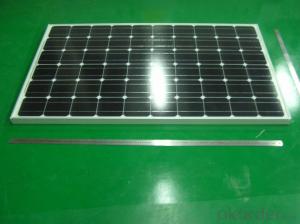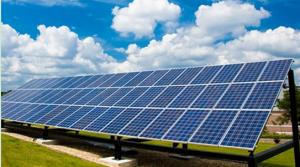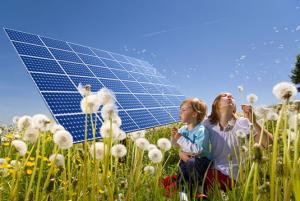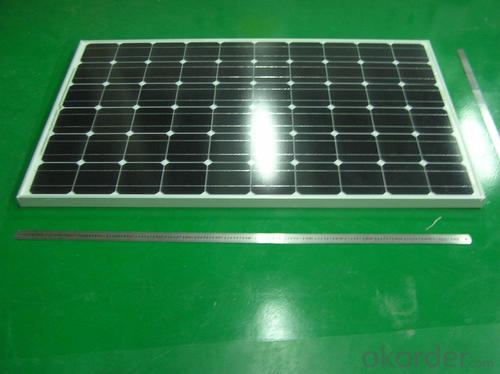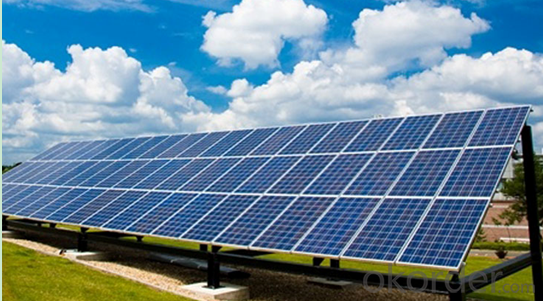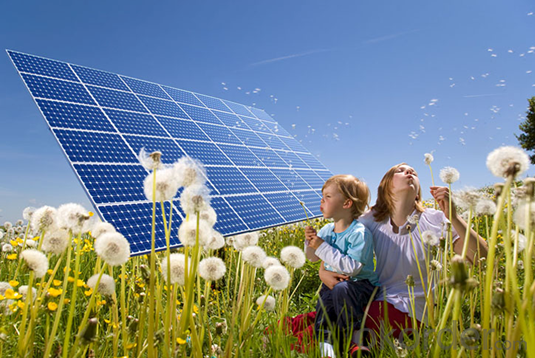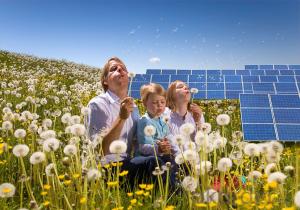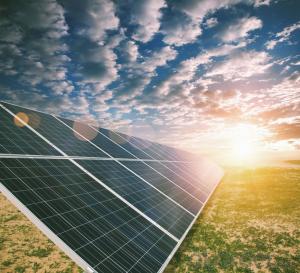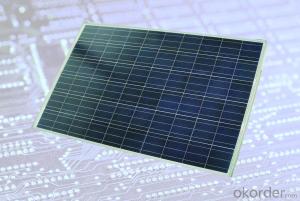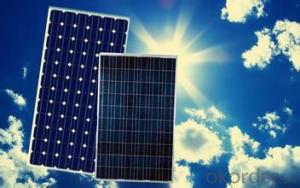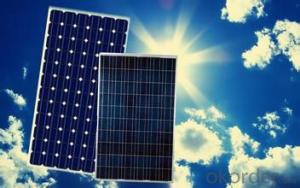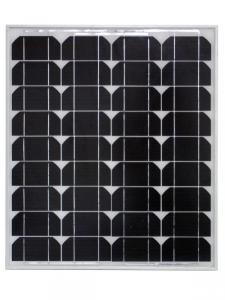Silfab Solar Panels Price - Single Crystal Silicon Components 70W CNBM China
- Loading Port:
- Shanghai
- Payment Terms:
- TT or LC
- Min Order Qty:
- 1 watt
- Supply Capability:
- 99999999 watt/month
OKorder Service Pledge
OKorder Financial Service
You Might Also Like
Description:
Currently more than 20 kinds of single crystal silicon components of blue sky solar production, power ranging from 50W to 315W, details please refer to annex "Si module parameter table".The products have obtained CE certification, CQC certification, TUV certification,Single crystal silicon components 70W
I. Solar Cell : High efficiency crystalline solar cell. Even if under the weak light, the solar module can produce maximum power output.
•II. Tempered glass (toughened glass): Anti-reflecting coating and high transmission rate glass increase the power output and mechanical strength of solar module.
•III . EVA and TPT: Using high quality EVA and TPT to prevent destroying and water
•IV . AI frame: Without screw, corner connection. 6 holes on the frame can be installed easily.
•V . Junction box: Multi function junction box with water proof.
Model Type | Good Quality 185W Solar Panel |
Peak Power-Pmax(W) | 185W |
Open Circuit Voltage-Voc(V) | 44.2 |
Maximum Power Voltage-Vmp(V) | 36 |
Short Circuit Current-Isc(A) | 5.4 |
Maximum Power Current-Imp(A) | 5 |
Maximum System Voltage | 1000V DC |
Maximum Series Fuse Rating | 10A |
Power Tolerance | -1~+3% |
Temperature Coefficients of Pmax | -0.45%/℃ |
Temperature Coefficients of Voc | -0.348%/℃ |
Temperature Coefficients of Isc | 0.031%/℃ |
Nominal Operating Cell Temperature | 44.5±2℃ |
Standard Testing Condition(STC) | Irradiance:1000W/m²;Temperature:25℃;AM=1.5 |
Qualification Test Parameters | |
Operating Temperature | -40℃~+85℃ |
Storage Temperature | -40℃~+85℃ |
Pressure Bearing | ≥5400Pascal/m² |
Wind Bearing | ≥5400Pascal/m² |
Mechanical Characteristics | |
Cell Size | Mono 125*125mm±0.5 |
No.of Cells | 72pcs(6*12) |
Dimension | 1580*808*40mm |
Weight | 15.5Kg |
Glass | 3.2mm High Transmission,Low Iron |
Frame | Anodized Aluminum Alloy |
Junction Box | IP65Rated |
Internal Diodes | 3 Bypass Diodes |
Cable | 1*4.0mm² Length 900mm |
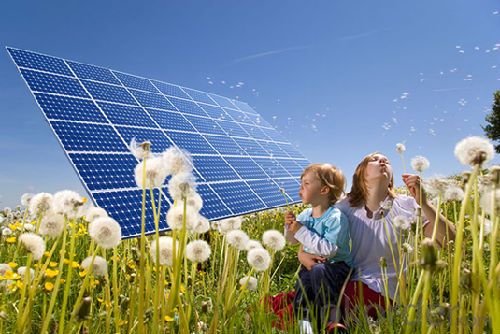
FAQ;What's your products warranty?
Products Guarantee 12 yrs free from defects in materials and workmanship Performance Guarantee No less than 90% within 10yrs and no less than 80% within 25yrs
- Q: i have to do a science fair project and thought it would be cool to make a solar powered vw bus. i have 2 6volt solar panels to power a dc motor that works off of 9v 2v or 8v. i also bought a 2nd motor because the first wasnt workin for us. this one is a 3v motor. ive had them in the sun but they wont work. please help, thanks
- A 2V battery designed for a current max of 200mA, can turn on a 2W lamp. If you want to turn on a 2V 200Watt lamp, you need a bigger battery capable of providing 6 amps!! Similarly the solar panel you have can produce a voltage, but when connected to a motor, the voltage might drop to much lesser value!! So apart from voltage you also need to know current taken by motor. Further, motors have a habit of not starting, but once prodded (mechanically rotate the shaft with hand), they may run. If you are in that border area, give a turn to the motor and see.
- Q: How much space is required for solar panel installation?
- The amount of space required for solar panel installation varies depending on factors such as the size and type of panels used, as well as the energy needs of the property. On average, a residential solar panel system typically requires about 100-400 square feet of roof space per kilowatt of installed solar capacity. Additionally, ground-mounted systems may require larger areas, typically ranging from a few hundred to several thousand square feet depending on the system size. However, it is important to consult with a professional solar installer to determine the specific space requirements for your individual project.
- Q: Can solar panels be used for powering an airport or transportation hub?
- Yes, solar panels can be used to power an airport or transportation hub. Solar energy is a clean and renewable source of power that can be harnessed to generate electricity. By installing solar panels on rooftops, parking lots, or even dedicated solar farms, airports and transportation hubs can significantly reduce their carbon footprint and reliance on traditional energy sources.
- Q: I have tried researching on the internet and just cant find any real answer. I know that the amount of electricity produced when taking in the suns rays depends on the placement of the solar panels but I am just looking for ball park figures. Thanks
- call your power company and ask them how much they pay for each kWh you feed back into the grid (the price may vary for different times of the day). then multiply that by however much electricity you are producing.
- Q: Can solar panels be installed on a canopy or pergola?
- Yes, solar panels can be installed on a canopy or pergola. In fact, installing solar panels on these structures can provide dual benefits, offering shade and generating renewable energy simultaneously. This innovative approach allows for the efficient utilization of space and can be a great solution for homeowners or businesses looking to maximize their solar energy production while enhancing their outdoor living spaces.
- Q: Can solar panels be installed on water bodies or reservoirs?
- Yes, solar panels can be installed on water bodies or reservoirs. This is known as a floating solar power plant or floating photovoltaic system. It involves placing solar panels on floating platforms that are anchored to the bottom of the water body or reservoir. This innovative approach allows for the utilization of otherwise unused space, reduces evaporation, and provides cooling benefits to the solar panels, increasing their efficiency.
- Q: OK so how do these solar panels supplement the AC from the grid? Like do they invert the output of the solar panels and sync two AC sources together? If so how and with what? Or do they convert the AC from the grid to DC and then supplement and then invert it? If so how and with what? Thanks
- The okorder /
- Q: Can solar panels be installed on a theater or entertainment venue?
- Yes, solar panels can be installed on a theater or entertainment venue. In fact, many theaters and entertainment venues have embraced solar energy as a sustainable and cost-effective solution for their energy needs. Solar panels can be installed on the roof or any available open space surrounding the building, generating clean and renewable electricity to power the venue's operations. This not only helps reduce their carbon footprint but also saves on energy costs in the long run.
- Q: Can solar panels be used for powering a hotel or hospitality establishment?
- Yes, solar panels can definitely be used to power a hotel or hospitality establishment. Solar energy is a reliable and renewable source of power that can be harnessed to meet the energy demands of such establishments. By installing solar panels, hotels and hospitality establishments can not only reduce their carbon footprint but also save on electricity costs in the long run. Moreover, advancements in solar technology have made it possible to store excess energy and use it during non-sunlight hours, ensuring a consistent power supply for the establishment.
- Q: when building a solar panel should the diode be on the positive or negative sidelittle more detail i just built a solar panel and im running it to a grid tie converter should i put diodes in if i add another panel or are they only for battery systems?
- Bypass diodes would be in parallel with groups of solar cells in a panel. For example, if a module has 72 cells, maybe every 8 cells, there will be a bypass diode. A bypass diode does nothing except salvage some of the energy from the panel if some of the cells are shaded, and others are not. Or, if you have multiple panels in a series string, the bypass diodes allow the other panels in a string to continue to contribute energy when one panel is shaded. Unless you're forced to put the panel(s) where there will be shade during the day, the bypass diode does not matter. Commercial panels all include bypass diodes. Blocking diodes are generally NOT included on commercial panels. If you're going to a grid-tied inverter, you probably don't need one. There are stringent regulations on how panels must be grounded, and whichever side of the panel is grounded should not have a blocking diode. NEC regulations call for a continuous ground to earth. For example, if you have negative ground on your system, the blocking diodes, if any, should go on the positive terminal of the panel. By the way, if you're in the US or Canada, do understand that a home-built panel will not be legal to connect to a grid-tied system. And a grid-tied inverter that plugs into the wall will also be illegal. I'm only saying this because I don't want you to get hurt, or your house to burn down. Line power is nothing to be trifled with.
Send your message to us
Silfab Solar Panels Price - Single Crystal Silicon Components 70W CNBM China
- Loading Port:
- Shanghai
- Payment Terms:
- TT or LC
- Min Order Qty:
- 1 watt
- Supply Capability:
- 99999999 watt/month
OKorder Service Pledge
OKorder Financial Service
Similar products
Hot products
Hot Searches
Related keywords
